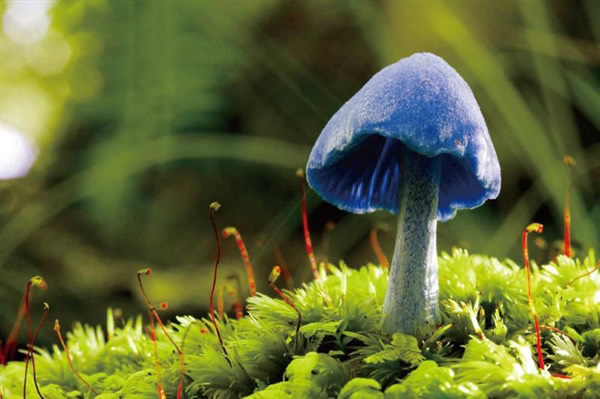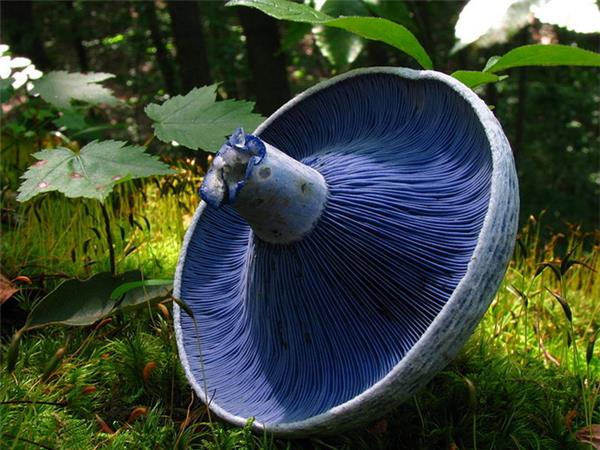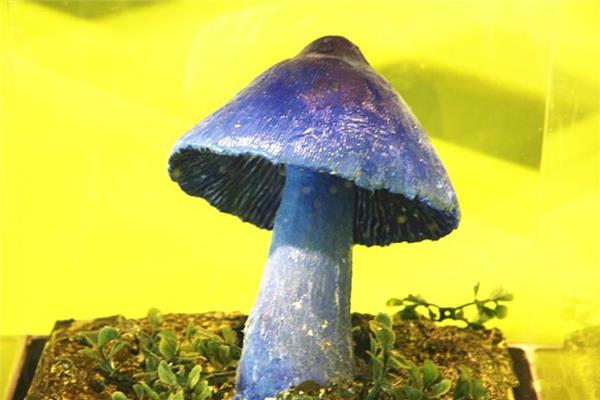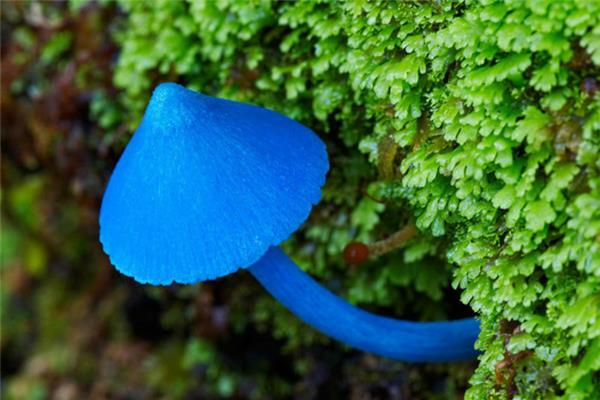How does the wonderful azure mushroom distinguish poisonous mushrooms from non-poisonous mushrooms
The sky blue mushroom is known as one of the "ten most wonderful mushrooms in the world". Like it, there are turkey tail mushrooms, which are all inedible mushrooms with unique appearance and high recognition.

What are sky blue mushrooms and turkey tail mushrooms
The azure mushroom, known as "Entoloma hochstetteri", lives in woodlands in western North and South Island of New Zealand and parts of India. This small mushroom is very delicate, mainly blue, with only slightly reddish spore folds. Its blue coat is caused by three kinds of pigments. In 2002, New Zealand issued a set of stamps covering six local strains, including sky blue mushrooms. In addition, the mushroom also appeared on the back of the 50-yuan note issued by the Reserve Bank of New Zealand in 1990. The sky blue mushroom is not edible, whether it is poisonous or not is still unknown.
The scientific name "Trametes versicolor" of turkey tail mushrooms is distributed all over the world and usually grows in groups on the trunks of dead trees. The name "turkey tail" comes from their appearance, which looks like the fan-shaped tail of a wild turkey. Sometimes, turkey tail mushrooms show green stripes as algae "colonize" on them. Although inedible, this mushroom has found its own place in the field of traditional Chinese medicine. Recently, scientists extracted polysaccharides-K (PSK) from turkey tail mushrooms, an immune system booster. At present, Japan has approved the use of polysaccharide-K as an adjuvant for cancer treatment.

Identification methods of poisonous mushrooms and non-toxic mushrooms
1. From the color point of view, poisonous mushrooms are bright in color, often red, green and yellow, with sudden ups and downs in the center of the mushroom.
two。 Umbrellas often have variegated spots, with filamentous or small residues or scales on the surface. The general color of non-toxic mushrooms is not bright, the mushroom cover is flat, and the umbrella surface is smooth.
3. From the secretion point of view, poisonous mushroom cover or injured parts, often secrete sticky thick liquid, there are reddish brown method, spicy and other peculiar smell, mushroom cover is easy to change color after tearing. And non-toxic mushrooms are generally dry, the liquid secreted after breaking is white, has a special fragrance, and the mushroom lid generally does not change color after tearing.
4. The mushroom wheel on the handle of the poisonous mushroom is easy to break, the lower part of the mushroom receptacle has cysts at the root, and the umbrella handle is difficult to tear open by hand. On the other hand, there is no mushroom wheel on the umbrella handle and no mushroom receptacle on the lower part of the non-toxic mushroom, and the umbrella handle is easy to be torn open by hand.
5. Identified by chemical method, the milk extruded from poisonous mushrooms was coated on paper, dried with a drop of concentrated hydrochloric acid, turned blue or red after 20 minutes, and turned blue after 30 minutes.

Third, how to fertilize potted mushrooms
Mushroom foot water: wash fresh mushroom root 5kg, add water 15ml 20kg, boil for 15 minutes, take clarification solution to water 40kg, dilute evenly and spray, which can prolong the peak period of mushroom production and thicken the fruiting body.
Soybean milk water: use 1 kg of mildew-free and spoiled soybeans, soak and grind into soybean milk, spray 50 kg of water filter residue. Can make the mushroom surface epidermis thicker, white and tender, the mushroom feet are strong and can increase production by about 10%, but it is prohibited when the temperature is high to prevent miscellaneous bacteria infection.
Fresh Carrot Juice: fresh carrots 5 kg chopped, add water 10 kg, boil for 30 minutes, filter residue to take juice, spray 50 kg of water, can promote the growth of mushrooms.
Culture material leaching solution: dry culture material 5 kg, add boiled water 50 kg, cover tightly closed, after cooling to slag spray. The solution can prolong the peak period of mushroom emergence and thicken the fruiting body.
Sugar solution: sucrose 1 kg (glucose powder 0.5 kg), 50 kg of water, spray after melting, use with caution when the temperature is high, avoid miscellaneous bacteria infection, pay attention to ant prevention after spraying. If 0.5 kg of calcium carbonate is added, the effect is better.

It is the most common method for most people to tell whether mushrooms are poisonous from their appearance. Although they are not edible, you might as well try to plant them, but in the process of planting, you must take protective measures to avoid risks such as accidental eating.
Related
- Wuhan Hospital Iron Tree Blooming Result Was Instantly Frightened by the Gardener Master
- Which variety of camellia is the most fragrant and best? Which one do you like best?
- What is the small blue coat, the breeding methods and matters needing attention of the succulent plant
- Dormancy time and maintenance management of succulent plants during dormancy
- Minas succulent how to raise, Minas succulent plant pictures
- What are the varieties of winter succulent plants
- How to raise succulent plants in twelve rolls? let's take a look at some experience of breeding twelve rolls.
- Attention should be paid to water control for succulent plants during dormant period (winter and summer)
- Watering experience of twelve rolls of succulent plants
- Techniques for fertilizing succulent plants. An article will let you know how to fertilize succulent plants.



